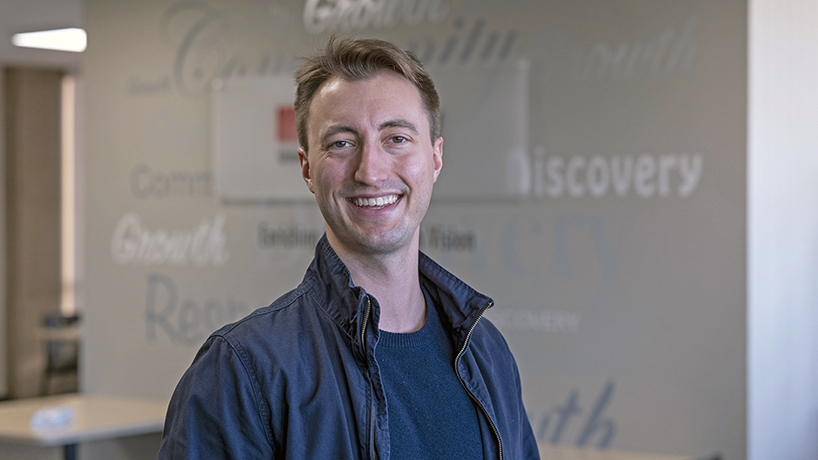
College of Optometry student Alex Fenson is part of curling’s Team Dropkin. In 2021, they won the National Championship and competed in the U.S. Olympic Trials, placing in the runner-up position. (Photo by August Jennewein)
Speak with Alex Fenson for a while, and you’ll notice that two words get said a lot: family and connection.
They’ll come up if you ask the College of Optometry student and competitive curler what drew him to the profession – “the doctor-patient connection” – or what brought him to the University of Missouri–St. Louis – “connection wise, I just felt part of the school.” You’ll hear them again if you ask him what enables the success of his curling team – “we’ve pretty much become a family” or what drew him to the sport – “I started in the local leagues with my family.”
You get the idea.
Family and connection bring together Fenson’s optometry and curling, empowering him to be a player competitive enough to take national titles and compete in the U.S. Olympic Trials last November and driven enough to make it through a demanding academic program at the same time.
“Being able to connect with people and know people on a personal level is really the reason I love both,” he said. “That’s what draws me to both.”
Fenson’s story starts in Bemidji, a small city in northern Minnesota that calls itself “the curling capital of the United States.” The son of curler Pete Fenson, an Olympic bronze medalist and seven-time national champion, Fenson grew up playing for fun starting around age 7.
“I grew up watching my dad play,” he said. “Their team was actually the first U.S. curling team to win an Olympic medal. So I grew up watching him play on the world and Olympic level. I grew fond of the sport and decided that I wanted to do it, too.”
Fenson began playing competitively when he was 17, forming a team with a childhood best friend, Mark Fenner, and others. They made it to Junior Nationals, eventually forming a team with another group as members aged out.
That would go on to become Team Dropkin, comprised of Fenson, Korey Dropkin, Joe Polo, Fenner and Tom Howell. Together, they went to Junior National Championships, World Junior Championships and National Championships.
“What I really like about curling is the strategy that’s involved and how tight the team is because we travel around the world all throughout the year,” Fenson said. “When we’re playing a hard competitive season, we curl three out of four weekends in a month. So being that close with the three other guys all the time you pretty much become a family, which is what I absolutely love.”
Highlights of their tenure together include placing silver in the World Junior Championship in 2016, winning the National Championship in 2021 and being the runner-up team at the U.S. Olympic Trials in 2021.
Six teams competed in a double round robin at the trials, followed by a best-of-three competition between the top two competitors, Team Dropkin and Team Shuster. Dropkin won the first game, only to fall to Shuster in the subsequent games.
“The experience was great,” Fenson said. “That’s huge for our team, just getting to play on a stage like that and play against some of the best in our nation. But we are quite disappointed because it was definitely in our grasp, and we just didn’t pull it out.”
With all the players in their mid-twenties, Team Dropkin would have been the youngest-ever U.S. team in the Olympics if they’d won. But that also demonstrates how much time the team has to achieve that goal. They’ve already begun thinking about their buildup to the next Olympics, which starts with the next National Championship this year and hopefully the World Championship.
Making this year’s Olympic Trials while beginning his optometry studies required discipline from Fenson and flexibility from the team. With him and another teammate living out of state, they’ve met to practice at least one weekend a month, often more, at the Olympic training center in southern Minnesota.
“I actually feel very fortunate that my curling team understands that I have this passion in optometry, too,” he said. “They’ve worked with me to still be on the team and still pursue this passion as well.”
Previously, Fenson had been curling full-time and working at his family’s pizza restaurant, Dave’s, a Bemidji institution. He’d planned to wait until after the Olympics to pursue optometry, but as the pandemic made curling uncertain, he saw an opportunity to make a move.
“I had told my curling team about wanting to go to optometry school,” he said. “They’re like, ‘Just do it, and we’ll make it work. We’ll figure out how to still have you on the team.’ So I started to apply.”
Fenson heard of UMSL’s College of Optometry from friends who’d gone to school at Logan Chiropractic, which has opened up its cadaver lab to UMSL optometry students. He visited the school and immediately fell in love with the small class sizes and tight-knit community.
Though he describes balancing both passions as “challenging,” Fenson has already discovered some favorite subjects, anatomy and physiology and neuroanatomy. He’s already thinking about the possibility of a residency after completing the program and, with any luck, competing in the Olympics, which will take place the year after he’s scheduled to graduate.
“People say the eye is the window into the soul,” he said. “It’s super intriguing because it’s super intricate. It’s really, really interesting to me.”














